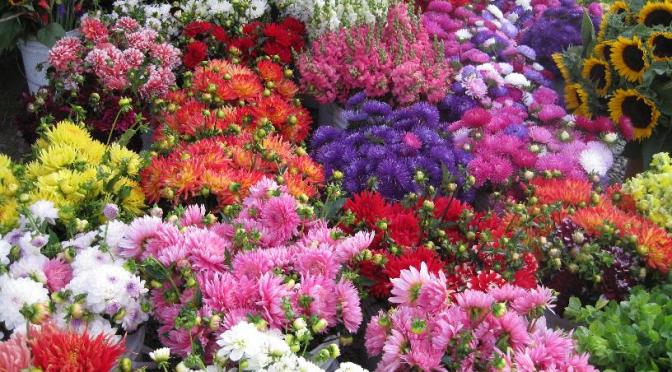Hanakotoba literally translated means “word flower”, and is the Japanese “language of flowers”. In this practice, plants are given codes and passwords that evoke the emotion inspired by the physiological characteristics and colors of the flowers, according to Wikipedia.
There is a clear relationship between the color of flowers, the most distinctive and resplendent expression of color in the natural world, and its meaning to each individual’s and/or cultural experiences of the color. This can be deeply personal. Artists have long associated moods, feelings and emotions with certain colors. Blue for example, is associated with feeling calm and cozy, while in western culture it represents masculine competence and quality. Blues and purples can also evoke feelings of apathy. Yellow is associated with anxiety. For others, the color yellow can mean warmth, as is the case with orange and red. The color white symbolizes purity and innocence in the west, while it can represent mourning in some eastern traditions.
Though the scientific research behind it is limited, colors may impact a person’s stress level, blood pressure, metabolism, and eye stress, according to Kendra Cherry in About.com’s “Color Psychology”.
The Chinese advanced the practice of chromotherapy for healing (source: Kendra Cherry, About.com’s Color Psychology), and here are sample associations between colors and their healing properties:
Red was used to stimulate the body and mind and to increase circulation.
Yellow was thought to stimulate the nerves and purify the body.
Orange was used to heal the lungs and to increase energy levels.
Blue was believed to soothe illnesses and treat pain.
Indigo shades were thought to alleviate skin problems.
Pink expressed the light, quiet, sweeter side of love
Below are some of the flowers and their HanaKotoba meanings. See if the chromotherapy meanings or their cultural associations of color match up at all with the Hanakotoba meanings:
Scientific Name– Japanese Name– Romaji– English Meaning–
Amaryllis Belladonna
アマリリス Amaririsu Amaryllis Shy  Amarylis Flower
Amarylis Flower
Anemone Narcissifolia
アネモネ Anemone Anemone Sincere  Anenome Flower
Anenome Flower
Aster Tataricus
紫苑 Shion Aster tataricus Remembrance
Azalea
躑躅 Tsutsuji Azalea Patient/Modest  Pink Azalea
Pink Azalea
Common Bluebell
ブルーベル Burūberu Bluebell Grateful
Camellia Japonica
椿 Tsubaki Camellia (Red) In Love, Perishing with grace  Camellia Japonica
Camellia Japonica
Camellia Japonica Nobilissima
椿 Tsubaki Camellia (White) Waiting
Carnation
カーネーション Kānēshon Carnation Fascination, Distinction, and Love
Cherry Blossom
桜 Sakura Cherry Blossom Kind/Gentle  Cherry Blossom
Cherry Blossom
Yellow Chrysanthemum
黄菊 Kigiku Chrysanthemum (Yellow) Imperial
Chrysanthemums
白菊 Shiragiku Chrysanthemum (White) Truth  Chrysanthemum
Chrysanthemum
Four Leaf Clover
(四つ葉の) クローバー (Yotsuba no) kurōbā Four-leaf clover Lucky
Daffodil
水仙 Suisen Daffodil Respect
Dahlia
天竺牡丹 Tenjikubotan Dahlia Good taste  Dahlia
Dahlia
Daisy
雛菊 Hinagiku Daisy Faith
Forget-me-not
勿忘草 Wasurenagusa Forget-me-not True love  Forget-Me-Not
Forget-Me-Not
Freesia
フリージア Furījia Freesia Childish/Immature
Gardenia
梔子 Kuchinashi Gardenia Secret love
Habenaria radiata
鷺草 Sagiso Habenaria radiata My thoughts will follow you into your dreams
Hibiscus
ハイビースカス Haibīsukasu Hibiscus Gentle
 Hibiscus
Hibiscus
Honeysuckle
忍冬 Suikazura Honeysuckle Generous  Honeysuckle
Honeysuckle
Hydrangea
紫陽花 Ajisai Hydrangea Pride
Iris
アイリス, 菖蒲 Ayame Iris Good News/Glad tidings/loyalty  Japanese Purple Iris
Japanese Purple Iris
Lavender
ラベンダー Rabendā Lavender Faithful
White Lily
白百合 Shirayuri Lily (White) Purity/Chastity
Tiger Lily
鬼百合 Oniyuri Tiger Lily Wealth  Tiger Lily
Tiger Lily
Morning Glory
朝顔 Asagao Morning Glory Willful promises  Morning Glory
Morning Glory
Narcissus
水仙 Suisen Narcissus Self-Esteem
Peony
パンジー Panjī Pansy Thoughtful/Caring  Orange Peony
Orange Peony
Red Poppy
雛芥子 Hinageshi Poppy (Red) Fun-Loving
Red Rose
紅薔薇 Benibara Rose (Red) Love/In love
White Rose
薔薇 Bara Rose (White) Innocence/Silence/Devotion .jpg) White Rose
White Rose




















 Hair Cap/ Tree Moss
Hair Cap/ Tree Moss Orange Crocosmia
Orange Crocosmia Black Creek Pebbles
Black Creek Pebbles
 Amarylis Flower
Amarylis Flower  Anenome Flower
Anenome Flower Pink Azalea
Pink Azalea Camellia Japonica
Camellia Japonica Cherry Blossom
Cherry Blossom Forget-Me-Not
Forget-Me-Not  Hibiscus
Hibiscus Honeysuckle
Honeysuckle Japanese Purple Iris
Japanese Purple Iris Tiger Lily
Tiger Lily.jpg) White Rose
White Rose

